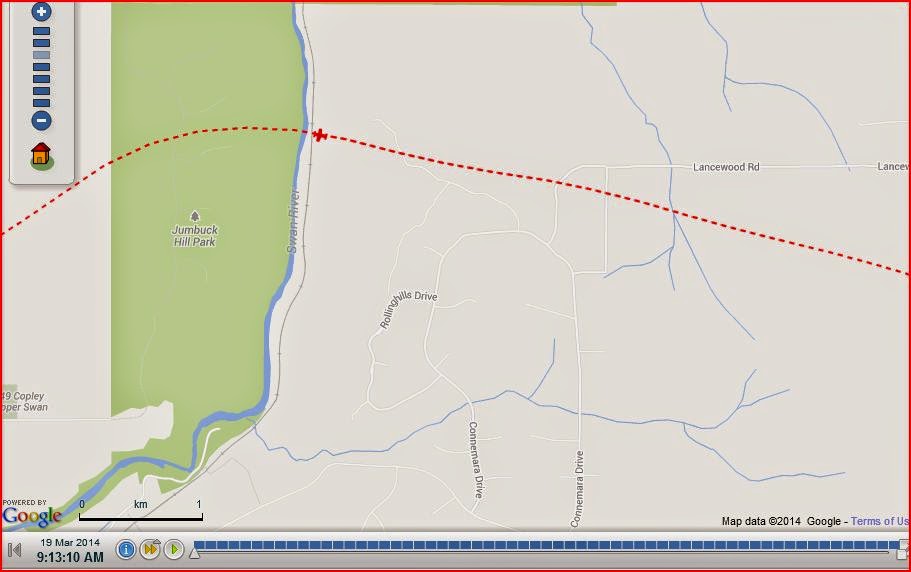Hi all,
Yesterday (click here), I posted information about the reported near collision between an "unknown object" and an aircraft owned by Skippers Aviation, on 19 March 2014, near Perth. Lying in bed last night, I suddenly realised that the WebTrak system of Air Services Australia (ASA), might contain some information about the event. The Webtrak system (click here) uses information from air traffic control secondary surveillance radars to provide information, overlayed on a map. I therefore went to the ASA WebTrak system for Perth and set it for the 19 March 2014 beginning at 0904hrs WST.
Enter the Skippers aircraft:
At 0909hrs WST a DH8C aircraft, shown as flying from YKBL (Kambalda, WA) appears on the radar replay, near the locality of Chidlow. This would be the aircraft described in the Australian Transport Safety Bureau's (ATSB) report on the incident.
The DH8C aircraft is shown following flight V0Z1432, registration VH-YIU, a B738, flying Darwin to Perth.
Some 20kms behind the DH8C aircraft was flight QFA485, Melbourne to Perth, an A332 at 6243ft. The crew of this aircraft would have had the DH8C to the front of them.
Close to QFA485 is a general aviation aircraft, a C82R at 8186ft. However the direction of this aircraft was facing away from the DH8C aircraft.
Here is a snip from the actual radar replay. The DH8C aircraft is the one nearest the top of the snip.
Here is a close up view:
Landing:
The radar replay shows V0Z1432 landed at 0916hrs WST; the DH8C landed at 0919hrs and QFA485 at 0920hrs.
Zooming in:
Zooming in on the radar replay reveals that at 0913hrs WST, the DH8C aircraft was at a height of 4124ft. Looking at the track of this aircraft displayed on the radar replay, there does seem to be a slight direction change at the reported time of the near collision with the "unknown object."
"Unknown object":
There is absolutely no other aircraft shown near the DH8C aircraft, on the radar replay. However, it should be remembered that the air traffic control secondary surveillance radar only shows objects (aircraft) displaying a transponder which provides identification details to air traffic controllers.
In summary:
I believe that this is the first time that any researcher has used the ASA WebTrak to confirm details in an ATSB report, concerning a near collision between an "unknown object" and an Australian aircraft.
I would urge readers of this blog to go to the WebTrak website and examine the radar replay for themselves. WebTrak retains radar information for three months, so the plots should be available up until 19 June 2014 for you to take a look for yourselves. Naturally I await the release of the ATSB's report on the incident, which however, will not be available for some months.
Thank you again, to Melbourne based researcher, Paul Dean, for locating preliminary details of the incident on the website of the Australian Transport Safety Bureau.
An examination of aspects of Unidentified Anomalous Phenomena (UAP) from a scientific perspective.
Subscribe to:
Post Comments (Atom)
The latest SOL Foundation symposium
The SOL Foundation The latest SOL Foundation gathering took place between 24-27 October 2025, on the shores of Lake Maggiore, in northern I...
-
Introduction Anomalist Books have just published the sixth in the series of Jacques Vallee's "Forbidden Science" diaries. It...
-
Introduction In my last blog article , I compiled pieces of information, new to me, after reading Jacques Vallee's latest book " ...
-
Hi all, Introduction: The disappearance of Australian pilot Frederick Valentich, on 21 October 1978, over Bass Strait, Australia, has al...




Great work Keith. The ASA WebTrack website is a valuable tool in aircraft identification and is also equipped with the visual tool's in assisting oneself in visualizing basic information such as altitude, velocity and you can even set a home coordinate and it will display the closet approach of any given aircraft which has been picked by that radar. Great tool if someone is unsure of a light's in the sky scenario, at least it's one avenue which can be eliminated without too much vested investigative resources.
ReplyDeleteIvan
VufoA
Hi,
ReplyDeleteI thought I'd mention some thoughts about unidentified objects captured by radar.
Webtrack was a +20million dollar expenditure about a dozen years ago from Oz taxpayer to Lokheed that needs aircraft transponders to be active to better report height & identify aircraft tracked by radar. It is just a fancy radar-track map overlay. Clearly somebody made shitloads of money selling stuff some people think is a bargain, but don't really understand, or are on the make.
However, as unscrupulous aircraft operators like FTA know too well, when aircraft transponders are disabled, or 'fly below radar,' they will not be identifiably tracked, hence be correlated by noise monitors. FTA also masks transponder data for them to be identified as the nuisance operator they are. Apparently that is 'allowed.' If so, what's the point? Noise complaints to Parafield exceed Mascot in Sydney, all for foreign interests, FTA is a Chinese, HK based tax scam of another foreign 'investment' degrading lives of Australians.
In summary, visual contact is still required to identify aircraft.
stopparafieldairnoise.blogspot.com